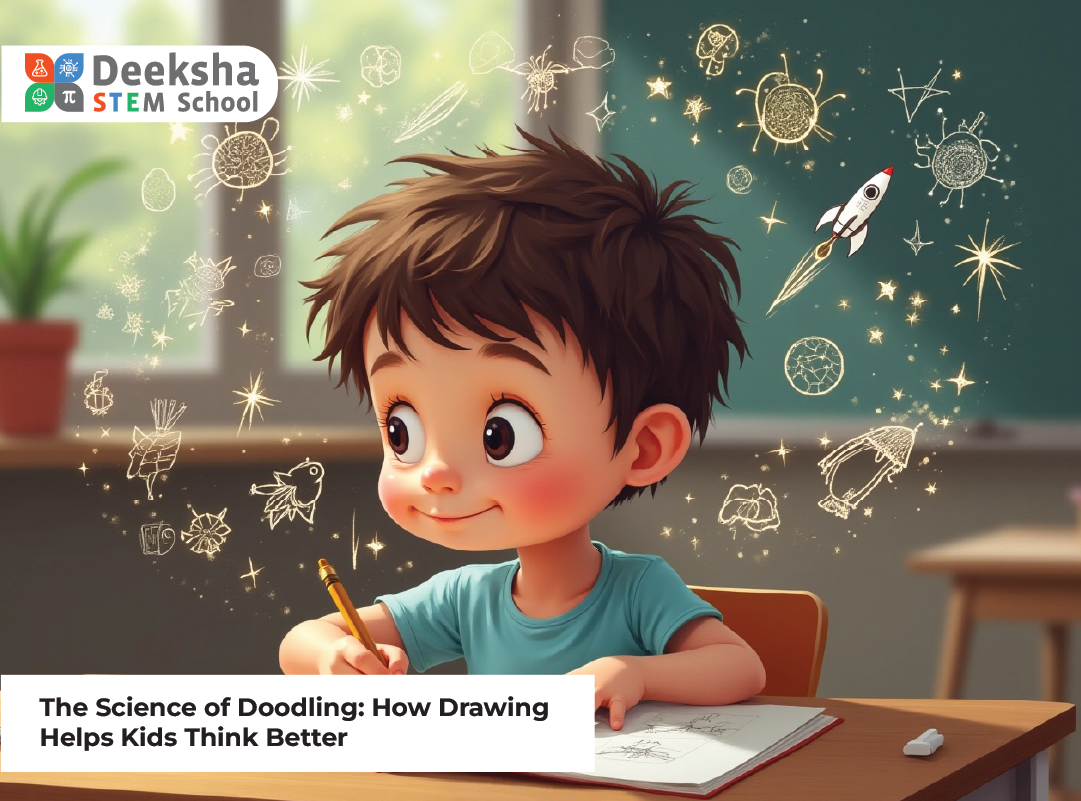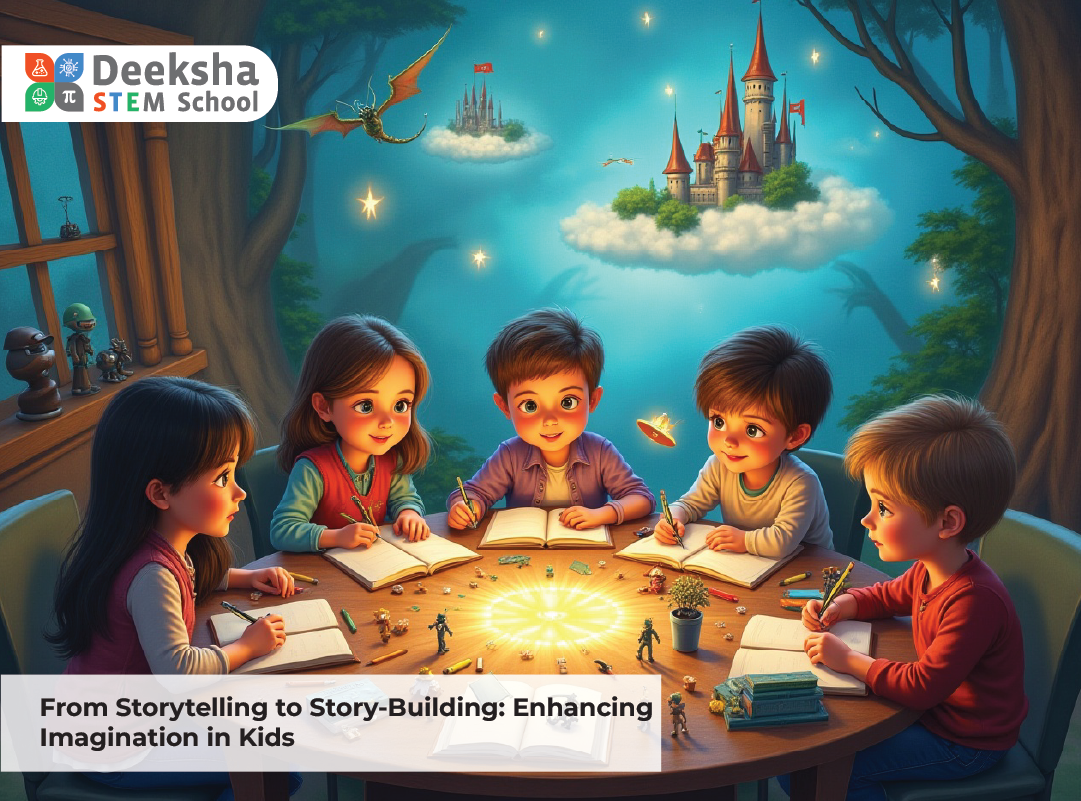The Science of Doodling: How Drawing Helps Kids Think Better

To many, doodling may seem like idle sketching, a distraction from real work or attentive listening. But decades of research suggest otherwise. Doodling—those spontaneous lines, shapes, or tiny drawings we create while thinking—can powerfully enhance a child’s ability to concentrate, remember, and process complex ideas.
At Deeksha STEM Schools, we understand that every child learns differently. That’s why we encourage alternative forms of expression and engagement, including structured doodling as a core part of how our students make sense of the world around them. Far from being a meaningless habit, doodling is a brain-boosting tool that promotes deeper learning.
What Is Doodling, Really?
Doodling isn’t about artistic talent or elaborate sketches. It’s a natural, spontaneous form of self-expression that includes:
- Abstract shapes, patterns, or repetitive designs
- Small cartoons, stick figures, or visual metaphors
- Diagrams or symbols that simplify complex thoughts
- Marginal scribbles made during classes or reading
Even seemingly random doodles are often reflections of a child’s inner thought processes. It’s a form of visual thinking—one that makes abstract information tangible and memorable.
How Doodling Benefits Cognitive Development
| Brain Function | How Doodling Supports It |
| Memory Retention | Encodes auditory input visually for stronger recall |
| Concentration | Prevents mental fatigue and keeps the brain subtly engaged |
| Creativity | Opens new ways of problem-solving and imaginative thinking |
| Emotional Processing | Acts as a therapeutic outlet for feelings and stress |
| Comprehension | Helps decode complex concepts through sketch-based analysis |
| Executive Functioning | Encourages planning, spatial awareness, and organization |
By doodling while listening, students can build stronger connections between what they hear and what they understand. This dual-coding approach—processing information both verbally and visually—makes learning stickier and more enjoyable.
Doodling in Action: Classroom Examples at Deeksha STEM
We believe in making learning multi-sensory. Here’s how doodling is thoughtfully integrated across different subjects:
- Science Notebooks: Students use diagrams, labeled sketches, and illustrated cycles to internalize biology and chemistry concepts
- Math Illustrations: Drawing number lines, geometric figures, or visual steps for equations boosts understanding
- Language & Literature: Creating visual summaries of chapters, character maps, or comic strips based on stories
- Mind Mapping Sessions: Brainstorming ideas visually using color-coded doodles, arrows, and word associations
- STEAM Projects: Merging art and science through blueprint sketches, infographics, and visual storytelling
We also encourage “Doodle Breaks” during long lessons—structured pauses where students reflect and respond through drawing. It improves information retention and reduces mental overload.
Why It Works: Scientific Insight
Doodling activates the default mode network (DMN)—a network of brain regions that remains active when the mind is at rest or engaged in passive thought. This state allows students to make unconscious connections and uncover creative insights.
According to a study published in Applied Cognitive Psychology, participants who doodled while listening to a monotonous recording remembered 29% more information than those who didn’t.
Benefits include:
- Improved focus: Doodling wards off daydreaming and increases attention span
- Cognitive engagement: Keeps working memory engaged with low-level stimulation
- Stress reduction: Calms nerves and reduces anxiety during tests or long lectures
- Creative flexibility: Encourages thinking outside the box and novel approaches to problems
Tips for Parents to Encourage Doodling
- Offer blank notebooks or sketchbooks alongside school supplies
- Create a doodle wall or board at home where kids can pin their drawings
- Encourage doodle journaling—a combination of thoughts and illustrations
- Use drawing as a review technique—ask your child to draw what they learned in class
- Join in! Collaborative doodling fosters connection and shows support
- Refrain from criticizing the style or neatness—process matters more than the product
Frequently Asked Questions
1. Isn’t doodling just a distraction?
- Not at all. Doodling, when allowed in structured ways, helps the brain process information better. It aids focus rather than hinders it, especially in students who struggle with traditional lecture formats.
2. How do I know if my child is learning through doodling?
- Ask them to explain their drawings. If they can articulate how a doodle represents a concept, they’re actively processing and retaining that information.
3. Can doodling help in subjects like math and science?
- Yes. Sketching out problems, building flowcharts for processes, and illustrating data visually helps children connect abstract ideas with real-world applications.
4. Should doodling be encouraged in classrooms?
- Definitely. Progressive classrooms now integrate doodling as part of visual learning strategies. It supports creativity, focus, and comprehension for a variety of learning styles.
5. How does Deeksha STEM integrate doodling into its curriculum?
- We’ve developed a curriculum that values visual learning tools. Our teachers incorporate visual note-taking, concept sketches, and design-thinking projects. Students are empowered to explore and express their learning visually across subjects.
Final Thoughts
Doodling is more than idle scribbling—it’s a visual form of thinking that unlocks untapped potential in children. When supported and structured, it becomes a cognitive bridge between listening and understanding, feeling and expressing, imagining and solving.
At Deeksha STEM Schools, we celebrate the diversity of learning styles and believe every child deserves to express their brilliance in their own unique way. Through words, numbers, or doodles, we give students the tools to think, reflect, and grow.
Come visit us at our campuses in Bannerghatta Road, Judicial Layout, Kengeri, and Vidyanagar to see how we transform classrooms into creative learning ecosystems—where even the smallest doodle makes a big difference.




